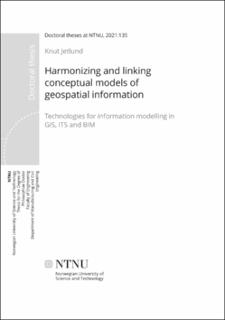| dc.contributor.advisor | Onstein, Erling | |
| dc.contributor.advisor | Huang, Lizhen | |
| dc.contributor.advisor | Hjelsvold, Rune | |
| dc.contributor.advisor | Haakonsen, Trond Arve | |
| dc.contributor.author | Jetlund, Knut | |
| dc.date.accessioned | 2021-04-30T13:12:22Z | |
| dc.date.available | 2021-04-30T13:12:22Z | |
| dc.date.issued | 2021 | |
| dc.identifier.isbn | 978-82-326-5703-2 | |
| dc.identifier.issn | 2703-8084 | |
| dc.identifier.uri | https://hdl.handle.net/11250/2740648 | |
| dc.description.abstract | Structured representations of phenomena from the real world in a digital geospatial environment are essential for developing, maintaining, and using the built and natural environment. In the real world, the phenomena relate to, influence and are influenced by other phenomena through their location, shape and extent. These geospatial characteristics and relations are vital in a digital environment as well.
The research presented in the thesis has studied technologies for modelling geospatial information in the three application domains of Geographic Information Systems (GIS), Intelligent Transport Systems (ITS) and Building Information Modelling (BIM). The three application domains have distinct roles in a digital geospatial environment but describe and handle many of the same real-world phenomena. Therefore, exchange and reuse of information between application domains, life cycle stages and stakeholders should be possible.
The research showed that improved syntactic interoperability could be achieved by describing information models from all three application domains according to a joint approach for information modelling. Improved semantic interoperability could be achieved by using the same core concepts in distinct information models. However, a complete harmonization of information models would not be appropriate, as information models from the three application domains need to describe the real world in different contexts. Therefore, Semantic Web technologies for linking and mapping should be applied for further improvements of semantic interoperability. | en_US |
| dc.language.iso | eng | en_US |
| dc.publisher | NTNU | en_US |
| dc.relation.ispartofseries | Doctoral theses at NTNU;2021:135 | |
| dc.relation.haspart | Conference Paper:
Jetlund, Knut. Experiences and challenges with standards for location referencing from the GIS and ITS domains. 25th ITS World Congress; 2018 | en_US |
| dc.relation.haspart | Article 1: Jetlund, Knut; Onstein, Erling; Huang, Lizhen. Information exchange between GIS and geospatial ITS databases based on a generic model. ISPRS International Journal of Geo-Information 2019 ;Volum 8.(3)
https://doi.org/10.3390/ijgi8030141
This is an open access article distributed under the Creative Commons Attribution License (CC BY 4.0) | en_US |
| dc.relation.haspart | Article 2: Jetlund, Knut. Improvements in automated derivation of owl ontologies from geospatial uml models. International Archives of Photogrammetry, Remote Sensing and Spatial Information Sciences 2018 ;Volum 42.(4) s. 351-358 | en_US |
| dc.relation.haspart | Article 3: Jetlund, Knut; Huang, Lizhen; Onstein, Erling. Adapted Rules for UML Modelling of Geospatial Information for Model-Driven Implementation as OWL Ontologies. ISPRS International Journal of Geo-Information 2019 ;Volum 8.(9) | en_US |
| dc.relation.haspart | Article 4: Jetlund, Knut; Onstein, Erling; Huang, Lizhen. IFC Schemas in ISO/TC 211 Compliant UML for Improved Interoperability between BIM and GIS. ISPRS International Journal of Geo-Information 2020 ;Volum 9.(4) | en_US |
| dc.relation.haspart | Article 5: Jetlund, Knut. A structure of UML profiles for modelling of geospatial information in GIS, ITS and BIM. ISPRS Annals of the Photogrammetry, Remote Sensing and Spatial Information Sciences 2020 ;Volum VI-4/W1-2020. s. 101-108 | en_US |
| dc.title | Harmonizing and linking conceptual models of geospatial information: Technologies for information modelling in GIS, ITS and BIM | en_US |
| dc.type | Doctoral thesis | en_US |
| dc.subject.nsi | VDP::Technology: 500::Building technology: 530 | en_US |
